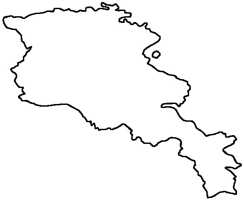
|
The Society of Folk Dance Historians (SFDH)
Armenian Dancing
[
Home |
About |
Encyclopedia | CLICK AN IMAGE TO ENLARGE |

|
 Armenia is the central republic of the three Transcaucasian Republics: Georgia, Armenia, and Azerbaijan. Thus Armenia has always been positioned at the edge of the Greco-Turkic world (as represented by Byzantium and subsequently by Ottoman Turkey) on one side and the Iranian world on the other side. Both of these massive cultural units has had a major impact on the development of Armenian dancing, as well as on other cultural areas.
Armenia is the central republic of the three Transcaucasian Republics: Georgia, Armenia, and Azerbaijan. Thus Armenia has always been positioned at the edge of the Greco-Turkic world (as represented by Byzantium and subsequently by Ottoman Turkey) on one side and the Iranian world on the other side. Both of these massive cultural units has had a major impact on the development of Armenian dancing, as well as on other cultural areas.
The dances of the Armenians can be divided into two major types: group line dances and solo and duet dances, in which the dancers do not touch each other. Occasionally in the line dances, which can be performed in broken circles or circles, the dancers may break away to wave kerchiefs or clap, but the basic dances find the dancers linked together holding hands, arms, shoulders, or little fingers.
The line dances are numerous: The Armenians perform scores of them. These dances are clearly part of a larger dance complex that once stretched from Northwest Europe to Asia Minor. The last traces end in Northwestern Iran, where line dances are common in Azerbaijan and Kurdistan (but not farther south or east where the performers in group dances do not link or touch).
Many of the specific dances performed by Armenians are commonly performed in the surrounding areas as well. The line dances are part of a wider choreographic area that includes Eastern Turkey, Kurdistan, and Azerbaijan. The names of the dances, the movements, steps and figures, and the melodies that accompany them are performed over this wide area, but the style of the dancing is sometimes different.
"For example, the same dances executed by the Turks as well as Armenians in Eastern Anatolia differ in style and mode completely." (And:1976, p.4).
The Turks originated in Central Asia where line dances do not exist. Clearly they found the line dances that had been popular in Anatolia for centuries very appealing and so adopted them. These line dances, known as Bar in both Armenian and Turkish, are very popular in Central and Eastern Anatolia where many Armenians made their homes before World War I.
The line dances of this region generally consist of one or more simple, repetitive patterns. These dances can be for men only, women only, or more generally and more recently, mixed. The leader is called "Gend-Bash" or circle leader, and he generally signals pattern changes by waving a kerchief.
Several researchers think that these dances may have originated for worship of the sun, moon, or earth. Whatever the proof of this is, we do know that in parts of Yugoslavia, dances were sometimes done contrary to the normal direction in a graveyard or other auspicious location to confound malevolent spirits.
In Armenia, as well as other parts of this larger choreographic area, dancing occurs in which the men dance in tiers, that is, standing on the shoulders of those below. Such dances are known in Georgia, Herzegovina, Croatia, Turkey, and Montenegro. The origins of this dance type are thought to be a part of ancient initiation rites in which older men carried boys entering puberty on their shoulders as a protective measure. When a youth passes into manhood, many preliterate societies consider him especially vulnerable to evil and inauspicious spirits, and so rituals are enacted to counter this.
Interestingly, while Armenia shares a choreographic culture in her line dances with Turkey and Kurdistan and Azerbaijan, the solo and duet dance tradition is shared only by Azerbaijan, Georgia, Daghestan, and other Caucasian and Iranian regions.
The solo and couple dances, while containing a reservoir of stock movements, are generally improvised. Among the solo dances, the men's dances are often spectacular with brilliant, athletic steps and figures to show the males' strength, dexterity, and military bearing. Such dances as Kertsy and Zurni Tringi are examples of this genre. Other dances such as Shalakho combine the bravura styling with humorous movements and jaunty styling. The best dancers make all of this dazzling performance look effortless. That these dances and this dance styling is unique to the Caucasus (and can be seen north into Russia and west to the Ukraine, but with different styling and figures) can be discerned by the lack of this dance tradition in neighboring areas south of Armenia except for the districts of Kars (in Turkey) and southern Azerbaijan (Iran).
The women's solo dances are more reminiscent of Iran and Azerbaijan, with emphasis on regal carriage and graceful hand movements. Armenian women, however, do not display the overt sensuality of Azerbaijan or Persian women in such dances as Jairani or Uzundara. Instead, modesty and shyness, highly valued traits in Armenian women, are stressed. Thus, even when employing the same basic movements, Armenian women look very different from their Moslem neighbors. At the same time, the Armenian female dancer seems less constrained than her Georgian counterpoint.
Mimetic dances are noted in this area. For women or men, this can take the form of imitating work or animal movements. In times of ritual, particularly spring, masks of awesome primitive aspect are worn. These masks, like those found in the Balkans and other parts of Eastern Europe are most often in the form of horned animals. Mimetic animal movements are sometimes seen on these occasions. Lisitsian gives several examples of the importance of the ram in this connection. (Tables CXX, CXXI, CXXII, CXXVII in Vol. I).
Interesting, too, are the rhythms. The line dances from this region display a wide variety of rhythms including asymmetrical ones, although 2/4 and 4/4 are prominent. The major rhythmic pattern of the Iranian Plateau is 6/8. So pervasive is it in the regions east of Turkey and the Arab world that it is called Shir-e Madar (mother's milk). This rhythm is also found widely in the Caucasus, but not in Turkey or the Arab world except near the frontiers of Iran or Transcaucasia.
Musical instruments popular throughout this wide area are the Zurna (double-reed wind) or clarinet, accompanied by the Dohol or Davuli (big drum). These instruments are especially popular for outside use. Inside, one can find such stringed instruments as the Tar (plucked string), Kemanche (bowed string), or the haunting strains of the Duduk (double reed) accompanied by the Daireh or Daf (frame drum).
The Armenian has chosen many elements from the wider world of dance and so, Armenians perform a wide variety of dances and share these with many neighbors, especially group dances with Azerbaijan, Kurdistan and Turkey; and solo dances with Azerbaijan, Iran, and Georgia. A comparison of music and dance names from each of these regions is most enlightening to see how widespread the dance forms are. Dancing is an art form that has always defied narrow national borders and ethnic prejudices.
BIBLIOGRAPHY
- And, Metin. Pictorial History of Turkish Dancing. Ankara,Dost Yainlari. 1976.
- Baykurt, Serif. Turk Halk Oyunlar (Turkish Folk Dances). Ankara Halkevler, Genel Merkez. 1965.
- Demirsipahi, Cemil. Turk Halk Oyunlari. Ankara, Turkyie Is Bankasi Kultur Yayinlari. 1975.
- Dzhalili, Dzhamila. Kurdskie Narodnye Pesni; Instrumentalnye Melodi (Kurdish Folk Song and Instrumental Melodies). N.D., Moscow,Sovietaki Kompoz.
- Dzhavishvili, D. Gruzinskif Narodnye Tansy (Georgian Folk Dances). Tvlisi (Tiflis) Sabochta Sakartveld. 1958.
- Hasanov, Kamal. Qadim Azerbaijan Khalq Raqslari (Old Azerbaijan Folk Dances in Azeri Turkish). Baku, Ishiq. 1983.
- Lisitsian, Srbui. Starinnye Plyaski; Teatralnye Predstavleniia Armianskara Narodna (Ancient Dance; Theatrical Performances of the Armenian Army). Yerevan, Armianskaya Akedemiia Nauk. Vol I - 1958, Vol II - 1972.
- Tkachenko,Tatiana. Narodnyi Tantsy (Folk Dances). Moscow, Isakust VO. 1954.
DOCUMENTS
- Armenia, a country
- Armenia and the Armenians, an article.
- Armenian Dance, an article.
- Armenian Dance History, an article.
- Armenian Dances, an article.
- Armenian Folk Dance Types, an article
- Armenian History and Culture, an article.
- Dr. Anthony Shay, teacher, choreographer, and ensemble director.
- Peoples of the North Caucasus, an article
- Transcaucasia, a region.
Used with permission of the author.
Printed in Folk Dance Scene, September 1987.
This page © 2018 by Ron Houston.
Please do not copy any part of this page without including this copyright notice.
Please do not copy small portions out of context.
Please do not copy large portions without permission from Ron Houston.